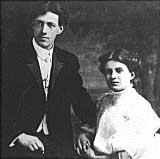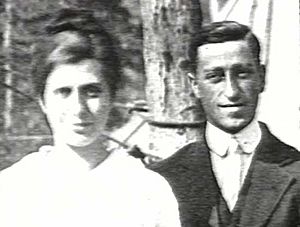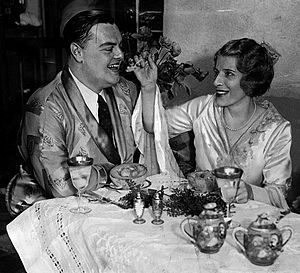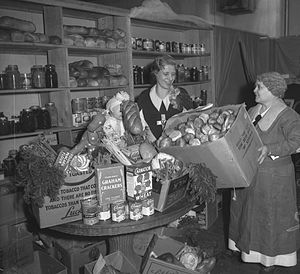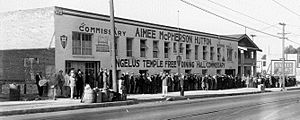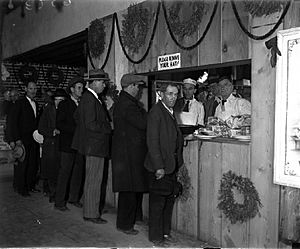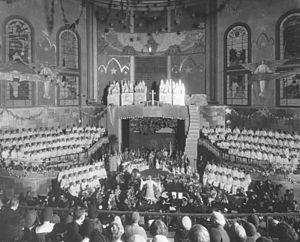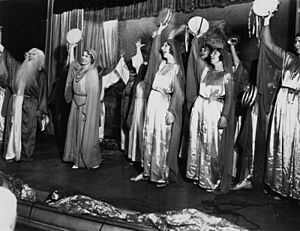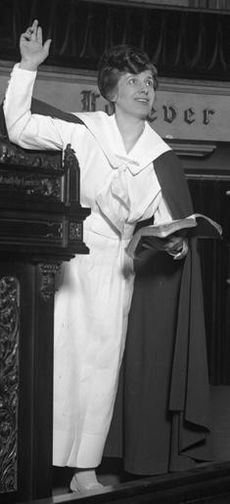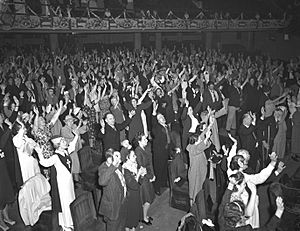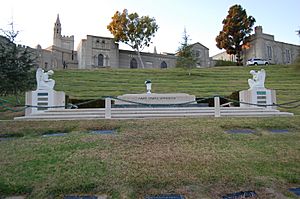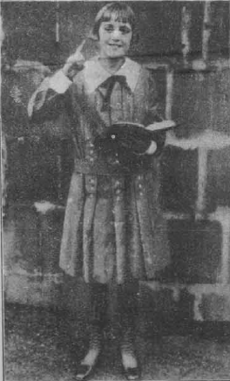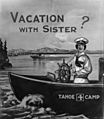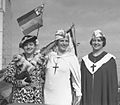Aimee Semple McPherson facts for kids
Quick facts for kids
Aimee Semple McPherson
|
|
|---|---|
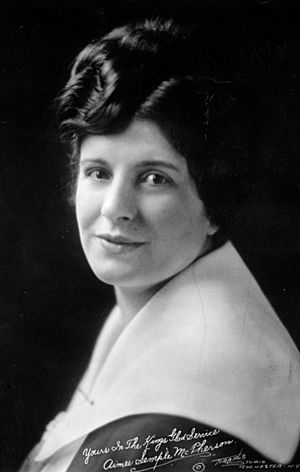
Sister Aimee (early 1920s)
|
|
| Born |
Aimee Elizabeth Kennedy
October 9, 1890 Salford, Ontario, Canada
|
| Died | September 27, 1944 (aged 53) |
| Resting place | Forest Lawn Memorial Park Cemetery (Glendale) |
| Known for | Founding the Foursquare Church |
| Spouse(s) | Robert Semple (1908–10; his death) Harold McPherson (1912–21; divorced) David Hutton (1931–34; divorced) |
| Children | Roberta Semple Salter (1910–2007) Rolf McPherson (1913–2009) |
Aimee Elizabeth Semple McPherson (née Kennedy; October 9, 1890 – September 27, 1944), also known as Sister Aimee or Sister, was a Canadian Pentecostal evangelist and media celebrity in the 1920s and 1930s, famous for founding the Foursquare Church. McPherson pioneered the use of broadcast mass media for wider dissemination of both religious services and appeals for donations, using radio to draw in both additional audience and revenue with the growing appeal of popular entertainment and incorporating stage techniques into her weekly sermons at Angelus Temple, an early megachurch.
In her time, she was the most publicized Protestant evangelist, surpassing Billy Sunday and other predecessors. She conducted public faith healing demonstrations involving tens of thousands of participants. McPherson's view of the United States as a nation founded and sustained by divine inspiration influenced later pastors.
McPherson's preaching style, extensive charity work and ecumenical contributions were a major influence on 20th century Charismatic Christianity.
Contents
Biography
Early life
McPherson was born Aimee Elizabeth Kennedy in Salford, Ontario, Canada, to James Morgan and Mildred Ona (Pearce) Kennedy (1871–1947). She had early exposure to religion through her mother, Mildred, who worked with the poor in Salvation Army soup kitchens. As a child she would play "Salvation Army" with classmates and preach sermons to dolls.
As a teenager, McPherson strayed from her mother's teachings by reading novels and attending movies and dances, activities disapproved of by the Salvation Army and her father's Methodist religion. In high school, she was taught the Theory of Evolution. She began to ask questions about faith and science, but was unsatisfied with the answers. She wrote to a Canadian newspaper, questioning the taxpayer-funded teaching of evolution. This was her first exposure to fame, as people nationwide responded to her letter, and the beginning of a lifelong anti-evolution crusade.
Conversion, marriage, and family
While attending a revival meeting in 1907, McPherson met Robert James Semple, a Pentecostal missionary from Ireland. She dedicated her life to Jesus and converted to Pentecostalism. At the meeting, she became enraptured by Semple and his message. After a short courtship, they were married in an August 1908 Salvation Army ceremony. Semple supported them as a foundry worker and preached at the local Pentecostal mission. They studied the Bible together, then moved to Chicago and joined William Durham's Full Gospel Assembly. Durham instructed her in the practice of interpretation of tongues.
After embarking on an evangelistic tour to China, both contracted malaria. Semple also contracted dysentery, of which he died in Hong Kong. McPherson recovered and gave birth to their daughter, Roberta Star Semple. On board a ship returning to the United States, she held religious services and classes.
After her recuperation in the United States, McPherson joined her mother Mildred working with the Salvation Army. While in New York City, she met accountant Harold Stewart McPherson. They were married in 1912, moved to Providence, Rhode Island, and had a son, Rolf Potter Kennedy McPherson, in 1913.
During this time, McPherson felt as though she denied her "calling" to go preach. Struggling with emotional distress and obsessive–compulsive disorder, she would weep and pray. In 1914, she fell seriously ill with appendicitis. McPherson later stated that after a failed operation, she heard a voice asking her to go preach. After accepting the voice's challenge, she said, she was able to turn over in bed without pain. In 1915, her husband returned home and discovered that McPherson had left him and taken the children. A few weeks later, he received a note inviting him to join her in evangelistic work.
Harold McPherson followed her to bring her home, but changed his mind after seeing her preaching, and joined her in evangelism, setting up tents for revival meetings and preaching. The couple sold their house and lived out of their "Gospel Car". Harold McPherson, despite his initial enthusiasm, wanted a more stable and predictable life, and returned to Rhode Island. In 1918 he filed for separation, then petitioned for divorce, citing abandonment; the divorce was granted in 1921.
McPherson remarried in 1932 to actor and musician David Hutton. McPherson and Hutton separated in 1933 and divorced in 1934. McPherson later publicly repented of the marriage for both theological and personal reasons and later rejected gospel singer Homer Rodeheaver when he proposed marriage in 1935.
Ministry
As part of William Durham's Full Gospel Assembly in Chicago, McPherson became known for interpreting glossolalia, translating the words of people speaking in tongues. Unable to find fulfillment as a housewife, in 1913, McPherson began evangelizing, holding tent revivals across the Sawdust Trail. McPherson quickly amassed a large following, often having to relocate to larger buildings to accommodate growing crowds. She emulated the enthusiasm of Pentecostal meetings but avoided their unbridled chaos, in which participants would shout, tremble on the floor, and speak in tongues. McPherson set up a separate tent area for such displays of religious fervor, which could be off-putting to larger audiences.
In 1916, McPherson embarked on a tour of the Southern United States, and again in 1918 with Mildred Kennedy. Standing on the back seat of their convertible, McPherson preached sermons over a megaphone.
In 1917, she started a magazine, Bridal Call, for which she wrote articles about women's roles in religion; she portrayed the link between Christians and Jesus as a marriage bond. Along with taking women's roles seriously, the magazine contributed to transforming Pentecostalism into an ongoing American religious presence.
In Baltimore in 1919 she was first "discovered" by newspapers after conducting evangelistic services at the Lyric Opera House, where she performed faith-healing demonstrations. Baltimore became a pivotal point for her early career.
Career in Los Angeles
In 1918, McPherson moved to Los Angeles. Mildred Kennedy rented the 3,500-seat Philharmonic Auditorium, and people waited for hours to get into the crowded venue. Afterwards, attendees of her meetings built a home for her family. At this time, Los Angeles was a popular vacation destination. Rather than touring the United States, McPherson chose to stay in Los Angeles, drawing audiences from both visitors and the city's burgeoning population. Her ministry to tourists allowed her message to spread nationwide.
For several years, she traveled and raised money for the construction of a large, domed church in the Echo Park area of Los Angeles, named Angelus Temple, in reference to the Angelus bell and to angels. Not wanting to incur debt, McPherson found a construction firm willing to work with her as funds were raised "by faith", beginning with $5,000 for the foundation. McPherson mobilized diverse groups to fund and build the church, by means such as selling chairs for Temple seating. In his book 'Growing up in Hollywood' Robert Parrish describes in detail attending one of her services.
Raising more money than expected, McPherson altered the plans and built a "megachurch". The endeavor cost contributors around $250,000. Costs were kept down by donations of building materials and labor. The dedication took place in 1923.
Enrollment grew to over 10,000, and Angelus Temple was advertised as the largest single Christian congregation in the world. According to church records, the Temple received 40 million visitors within the first seven years.
Despite some affinities with Pentecostals, her beliefs are interdenominational.
Charitable work
McPherson developed a church organization to provide for physical as well as spiritual needs. McPherson mobilized people to get involved in charity and social work, saying that "true Christianity is not only to be good but to do good." The Temple collected donations for humanitarian relief including for a Japanese disaster and a German relief fund. Men released from prison were found jobs by a "brotherhood". A "sisterhood" sewed baby clothing for impoverished mothers.
In June 1925, after an earthquake in Santa Barbara McPherson interrupted a radio broadcast to request food, blankets, clothing, and emergency supplies. In 1928, after a dam failed and the ensuing flood left up to 600 dead, McPherson's church led the relief effort. In 1933, an earthquake struck and devastated Long Beach. McPherson quickly arranged for volunteers offering blankets, coffee, and doughnuts. McPherson persuaded fire and police departments to assist in distribution. Doctors, physicians, and dentists staffed her free clinic that trained nurses to treat children and the elderly. To prevent the power from being turned off to homes of overdue accounts during the winter, a cash reserve was set up with the utility company.
Drawing from her childhood experience with the Salvation Army, in 1927 McPherson opened a commissary at Angelus Temple offering food, clothing, and blankets. She became active in creating soup kitchens, free clinics, and other charitable activities during the Great Depression, and fed an estimated 1.5 million. Volunteer workers filled commissary baskets with food and other items, as well as Foursquare Gospel literature. When the government shut down the free school-lunch program, McPherson took it over. Her giving "alleviated suffering on an epic scale".
In 1932, the commissary was raided by police, allegedly to locate a still used to make brandy out of donated apricots. As a consequence, the commissary was briefly shut down, and the staff was let go. However, students from her Foursquare Gospel Church's L.I.F.E. Bible College filled in.
As McPherson refused to distinguish between the "deserving" and the "undeserving," her temple commissary became known as an effective and inclusive aid institution, assisting more families than other public or private institutions. Because her programs aided nonresidents such as migrants from other states and Mexico, she ran afoul of California state regulations. Though temple guidelines were later officially adjusted to accommodate those policies, helping families in need was a priority, regardless of their place of residence.
Ministry
Style of ministry
In August 1925, McPherson chartered a plane to Los Angeles to give her Sunday sermon. Aware of the opportunity for publicity, she arranged for followers and press at the airport. The plane failed after takeoff and the landing gear collapsed, sending the nose of the plane into the ground. McPherson used the experience as the narrative of an illustrated sermon called "The Heavenly Airplane", featuring the devil as pilot, sin as the engine, and temptation as propeller.
On another occasion, she described being pulled over by a police officer, calling the sermon "Arrested for Speeding". Dressed in a traffic cop's uniform, she sat in a police motorcycle and blared the siren. One author in attendance wrote that she drove the motorcycle across the access ramp to the pulpit, slammed the brakes, and raised a hand to shout "Stop! You're speeding to Hell!"
McPherson employed a small group of artists, electricians, decorators, and carpenters, who built sets for each service. Religious music was played by an orchestra. McPherson also worked on elaborate sacred operas. One production, The Iron Furnace, based on the Exodus story, saw Hollywood actors assist with obtaining costumes.
Though McPherson condemned theater and film as the devil's workshop, its techniques were co-opted. She became the first woman evangelist to adopt cinematic methods to avoid dreary church services. Serious messages were delivered in a humorous tone. Animals were frequently incorporated. McPherson gave up to 22 sermons a week, including lavish Sunday night services so large that extra trolleys and police were needed to help route the traffic through Echo Park. To finance the Temple and its projects, collections were taken at every meeting.
McPherson preached a conservative gospel, but used progressive methods, taking advantage of radio, movies, and stage acts. She attracted some women associated with modernism, but others were put off by the contrast between her message and her presentation.
The battle between fundamentalists and modernists escalated after World War I. Fundamentalists generally believed their faith should influence every aspect of their lives. Despite her modern style, McPherson aligned with the fundamentalists in seeking to eradicate modernism and secularism in homes, churches, schools, and communities.
The appeal of McPherson's revival events from 1919 to 1922 surpassed any touring event of theater or politics in American history. She broke attendance records recently set by Billy Sunday and frequently used his temporary tabernacle structures to hold her meetings. One such revival was held in a boxing ring, and throughout the boxing event, she carried a sign reading "knock out the Devil". In San Diego the city called in the National Guard to control a revival crowd of over 30,000 people.
Faith healing ministry
McPherson's ability to draw crowds was also greatly assisted by her faith healing presentations. According to Nancy Barr Mavity, an early McPherson biographer, the evangelist claimed that when she laid hands on sick or injured persons, they got well because of the power of God in her. During a 1916 revival in New York, a woman in advanced stages of rheumatoid arthritis was brought to the altar by friends. McPherson laid hands on her and prayed, and the woman apparently walked out of the church without crutches. McPherson's reputation as a faith healer grew as people came to her by the tens of thousands. McPherson's faith-healing practices were extensively covered in the news and were a large part of her early-career success. Over time, though, she largely withdrew from faith-healing, but still scheduled weekly and monthly healing sessions which remained popular until her death.
The Foursquare Church
McPherson published the weekly Foursquare Crusader. She began broadcasting on radio in the early 1920s. In April 1922, she became the first woman to preach a sermon wirelessly. With the opening of Foursquare Gospel-owned KFSG in 1924, she became the second woman granted a broadcast license by the Department of Commerce, which supervised broadcasting at the time.
In October 1922, she explained her vision of "Foursquare Gospel" (or "Full Gospel") in a sermon in Oakland, California. This represents the 4 aspects of the ministry of Jesus Christ; Savior, Baptizer with the Holy Ghost, Healer and King.
McPherson racially integrated her tent meetings and church services. On one occasion, as a response to integration, Ku Klux Klan members were in attendance, but after the service, their hoods and robes were found on the ground nearby. She is also credited with helping Hispanic ministries in Los Angeles.
War years
In the 1930s McPherson and the Foursquare Gospel Church explored Pacifism, a component of Pentecostalism. McPherson also considered Gandhi's views on pacifism, and Clinton Howard, chairman of the World Peace Commission, was invited to speak at the Temple. In 1932, she promoted disarmament. Foursquare leaders, alarmed at rapid changes in military technology, drew up an amendment inclusive of varied opinions on military service. Two views were held acceptable: the idea that one could bear arms in a righteous cause; and the view that killing of others, even in connection to military service, would endanger their souls. McPherson monitored international events leading up to the Second World War, believing that the apocalypse and the Second Coming of Christ were at hand.
All-night prayer meetings were held at the Temple starting in 1940 as Germany occupied Europe. She asked other Foursquare churches around the country to follow suit. She sent President Franklin Roosevelt's secretary, Stephen Early, an outline of her plans, and various officials expressed appreciation, including the governor of California.
At the outbreak of World War II, McPherson rejected the Christian pacifism popular in the Pentecostal movement, saying that, "It is the Bible against Mein Kampf. It is the Cross against the Swastika. It is God against the antichrist of Japan...This is no time for pacifism." The Temple itself became a symbol of homefront sacrifice for the war effort. Its white dome was painted black and its stained-glass windows covered in anticipation of air raids. To advertise the need to conserve gasoline and rubber, McPherson drove a horse and buggy to the Temple.
Rubber and other drives were organized, and unlimited airtime on her radio station, was given to the Office of War Information. She asked listeners to donate two hours a day for such tasks as rolling bandages. Money was raised to provide military bases with comfortable furnishings and radios. Newsweek published an article about McPherson, "The World's Greatest Living Minister" in 1943, noting that she had collected 2,800 pints of blood for the Red Cross; servicemen in her audience are especially honored, and the climax of her church services is when she reads the National Anthem. McPherson gave visiting servicemen autographed Bibles. She wrote:
What a privilege it was to invite the servicemen present in every Sunday night meeting to come to the platform, where I greeted them, gave each one a New Testament, and knelt in prayer with them for their spiritual needs.
She insulted Adolf Hitler and Hideki Tōjō, and became involved in war bond rallies. McPherson sold $150,000 worth of bonds in one hour in 1942, breaking previous records, then repeated the performance in 1944. The U.S. Treasury awarded her a special citation and the army made McPherson an honorary colonel. Her wartime activities included sermons linking the church and patriotism. She felt that if the Allies did not prevail, churches, homes, and everything dear to Christians would be destroyed.
McPherson's embrace of the total war strategy of the United States left her open to some criticism. The line between the church as an independent moral authority monitoring government became blurred. Japanese Americans' internment in relocation camps was overlooked, and she refused to allow her denomination to support Christians who remained pacifist. Church members and leaders were expected to be willing to take up arms. The pacifist clause, by her proposal, was eliminated by the Foursquare Gospel Church.
Death
On September 26, 1944, McPherson went to Oakland, California, for a series of revivals, planning to preach her popular "Story of My Life" sermon. When McPherson's son went to her hotel room at 10:00 the next morning, he found her unconscious with pills and a half-empty bottle of capsules nearby. She was dead by 11:15. It was later discovered that she had called her doctor that morning complaining of feeling ill from the medicine, but he was in surgery. She then phoned another doctor who referred her to yet another physician. However, McPherson lost consciousness before the third could be contacted.
The autopsy revealed a heart attack.
45,000 people waited in long lines, some until 2 a.m., to file past the evangelist, whose body lay in state for three days at the Temple. It later took 11 trucks to transport the $50,000 worth of flowers to the cemetery. Though they had left McPherson's employ on bad terms, her former assistant pastor Rheba Crawford Splivalo, daughter Roberta, and her mother Mildred Kennedy were also in attendance.
McPherson is buried in Forest Lawn Memorial Park Cemetery in Glendale, California. Following her death, the Foursquare Gospel church denomination was led for 44 years by her son Rolf McPherson.
Legacy and influence
After her death, the largely negative aspect of her media image persisted and became the dominant factor in defining McPherson for many in the public. Robert P. Shuler, whose caustic view of McPherson softened over the years, wrote that McPherson's flaws were many, yet she ultimately made a positive lasting impact on Christianity. He recognized her appeal as a combination of identifying with average citizens and an ability to preach in simple terms. Her legacy continued through the thousands of ministers she trained and churches planted worldwide. McPherson helped to reshape evangelical Christianity, making it relevant to American culture and personally involving for listeners.
McPherson influenced later ministers including child preacher Uldine Utley and Dr. Edwin Louis Cole, who went on to found the Christian Men's Network. Biographer Matthew Sutton wrote that McPherson helped to forestall the replacement of traditional Protestantism by new scientific and philosophical ideas. Liberal Christianity, which was growing in the late 19th century, regarded Biblical miracles as superstition or metaphor. McPherson's faith-healing ministry promoted the idea that miraculous healings could occur in modern times.
McPherson's ecumenical approach assisted Pentecostals in explaining their faith in the context of historic church doctrine. Mainline churches became exposed to differing beliefs about gifts of the Holy Spirit. They borrowed Pentecostal revival techniques including emotive expression, praise worship, and testimonials, forerunning the Charismatic Movement.
McPherson challenged expectations for women. Her gender and divorces were of particular concern to many fundamentalist churches with which she wanted to work. However, atheist Charles Lee Smith remarked that she had an extraordinary mind, "particularly for a woman".
Her continual work at church alliance-building finally bore posthumous fruit. Foursquare Gospel Church leaders joined the National Association of Evangelicals in 1952 and helped organize the Pentecostal World Fellowship. Pentecostalism, which once advocated separatism and was on the fringes of Protestantism, became part of mainstream Christianity.
The Foursquare church claims a membership of over 7.9 million worldwide in 2019.
Images for kids
-
After emerging from the Mexican desert, McPherson convalesces in a hospital with her family in Douglas, Arizona, 1926. District Attorney Asa Keyes stands to the far left with Mildred Kennedy (mother) next to Roberta Star Semple, middle left (daughter). On the far right, Deputy District Attorney Joseph Ryan is alongside her son, Rolf McPherson.
See also
 In Spanish: Aimee Semple McPherson para niños
In Spanish: Aimee Semple McPherson para niños


